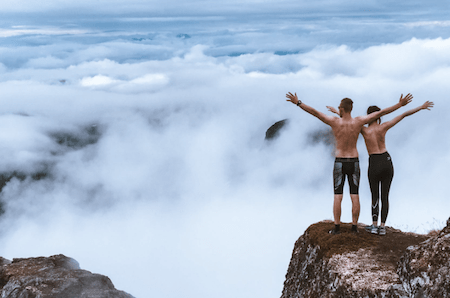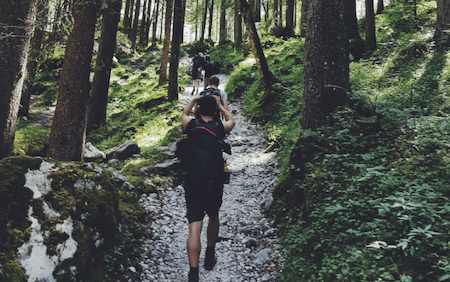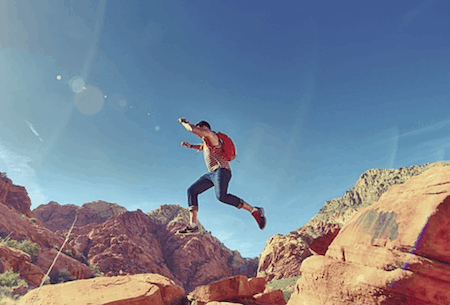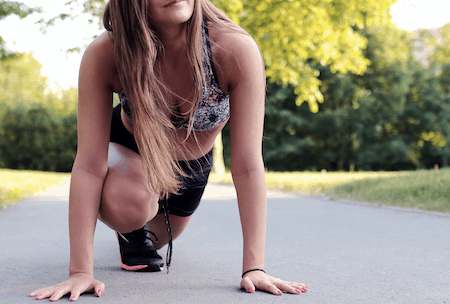Hiking is one of the most favored exercises for outdoor lovers.
Hiking has all the benefits- not only that of strengthening your body and burning calories, but also boosting your mood while providing you with scenic views of the great outdoors.
This activity is one of the easiest workouts, providing you the most and best of outcomes. However, even though it is a full-body exercise, it mostly affects the lower portion of your body.
Are you wondering why is hiking such a complete lower body workout?
Allow us to explain to you while we talk about how it strengthens you in every possible way.
Table of Contents
How Hiking Is Different From Other Outdoor Exercises
Hiking is nothing but long, vigorous walks- ideally along with the country or up & down small hills.
Taking walks through nature while enjoying the scenic beauty and serene weather also earns it the title of recreational activity.
It is different than walking because walking usually involves flat grounds- whereas hiking is done on hills, terrains, or similar rocky and rough surfaces.
Hiking takes a lot more effort as it requires you to move to the higher, elevated ground and coming back down. Most of the time, it’s a one-day or overnight activity.
Again, it is different from trekking- which involves covering a wilder environment and takes multiple days or even weeks of commitment.
In conclusion, hiking is the perfect balance between walking and trekking- providing you with the best of both worlds as it heals your mind and strengthens your physique.
Why Hiking Is A Complete Lower Body Workout
Hiking is considered a full-body workout, although it mainly focuses on the lower body portion and your heart.
As hiking is walking uphill, defying gravity, and balancing weight carefully while coming downhill- it concentrates heavily on the lower body portion, which supports the weight of your body.
We can more easily realize it when we understand which lower body parts hiking helps and how;
#1. Hamstrings
Hamstrings are thigh muscles located between the hip and the knee, precisely at our rear upper thighs. Working with quads gives the knees flexibility and helps extend, move, or rotate our hips.
As a result, hiking both uphill and downhill requires shorter strides (than walking or running).
Being on your toe, defying gravity, and balancing weight heavily work these muscles. Once your hamstring is stronger, it is easier to walk and run, with less possibility of damaging your muscle.
Finding the right grade and pace or a fairly strenuous hike can help your hamstrings become stronger. Angled pathways are known to work the hamstrings more than steeper pathways.
#2. Quadriceps
Quadriceps, more commonly known as quads, are the strongest and largest muscles in the human body.
They are situated at the front of your thigh and are made of four muscles each. These muscles keep your knees stable and help you with basic activities like standing, walking, running, etc.
Hiking downhill works and tones your quads better than hiking uphill- as it needs to support your body weight, stabilizing your knees and hips against gravity as you take each step.
It is equated with using the stairclimber to work out at the gym. As previously mentioned, though, hiking uphill can also work the quads intensely if the trail is steeper- as then the body weight shifts from the hamstrings to the quads.
#3. Glutes
Glutes are short for the gluteal muscles, made of three muscles that make up the buttocks. They help support your torso and are extremely important for balancing your body weight.
In addition, they help rotate your hips to allow you to extend the legs both to your front and back.
Hiking uphill makes the glutes work rigorously, as it carries your body weight and the weight of your backpack.
So, it has to work harder to keep your balance and weight aligned to help you go uphill against the gravity without falling.
#4. Calves
Calves are the back portion of your lower leg. Made of two large muscles, they connect your heels to the rest of your lower leg below the knee and help with movement.
They protect your feet, ankle, and knee during ascent and descent by balancing your steps. Hiking strengthens your calves and helps plant your feet properly to balance on the rocky hiking tracks.
#5. Hip Muscles
Naturally, 17 muscles make up the hip muscles. Hip muscles help support your lower back and glutes. They are crucial as they absorb shock and spread strains to other lower body parts.
Hiking works and strengthens all the hip muscles and helps prevent your lower back from straining quickly.
#6. Core (Lower Core)
The core is a group of muscles consisting of at least 20 muscles in the stomach, hips, abs, and lower back area.
Abdominal: Situated at the front of your body between your chest (thorax) and your pelvis, the abdominal is known more commonly as the stomach, belly, or tummy.
Strong abdominal muscles provide strength in the core region and better support your core.
These muscles help you keep the correct upright posture and help support any weight you put on the back. Hiking requires balance and proper posture- which in turn helps strengthen your abdominal muscles
Abs: Abs solely function to assist the torso in bending forward or the flexibility of the spine. They are a small fraction of the large group of core muscles.
Abs also help you maintain good posture. In addition, they prevent you from straining your lower back and help reduce the risk of lower back pain and injury.
Ab muscles wrap around the spine; hence stronger ab muscles provide more stability to your spine. Hiking works your abs as well and strengthens them, providing stability and flexibility.
Read Also: Affordable Hiking Backpack Review.
Other Benefits Of Hiking
Hiking is excellent not only for your lower body, but it also works wonders for other aspects.
Cardio
Cardio exercises are those that increase your heart rate. These types of exercises are widely known to help with weight loss by burning fats and calories faster.
In addition, they expand your lung capacity and increase your bone density.
Not only that, cardio exercises improve blood pressure and increase blood sugar levels. They drastically improve the condition of your heart and lower heart disease risks.
Mental Health
Hiking requires being in nature, which works great to relieve stress and boost your mood. Spending time outdoors can calm your anxiety and lower the risk of depression.
The adventurous hiking trips can release happy hormones like dopamine, serotonin, and endorphin and improve your overall mental health.
Moreover, hiking outdoors improves your sensory perception and opens up your senses further.
Boost Your Hiking Strategies
Hiking can improve your health, but there are some actions you can take to improve your hiking game and lower risks and injuries.
-
Find Your Pace
Start at a slower pace. For beginners, a short hike at local spots is ideal. Once you build a habit and start training your body, gradually work your way up and start going for longer trails.
Once you feel ready, start exploring uneven trails as they can work your muscles better and improve your balance.
-
Balance Your Weight
You must maintain your balance and a good posture- otherwise, you may end up injuring yourself. Carrying a pole to support yourself can help you get a better, safer grip as you take each step.
A balanced weight of the backpack can increase your calorie burn and strengthen your lower back muscle- but carrying too much weight can strain your back muscle and induce back pain.
-
Warm Yourself Up
It is a great idea to warm up your body before you start hiking. Doing some stretches and some light warm-up exercises can prepare your muscles for the hike ahead.
This way, you won’t be straining your muscles as quickly.
Conclusion
Hiking is overall an excellent exercise for the human body and a breather for the human mind.
Even though we’ve learned why hiking is such a complete lower body workout, we should also remember that it helps strengthen the whole body, including arms and upper body.
At the same time, hiking is great for cardio.
So, why wait any longer?
Prep your backpack, find a scenic trail close to you- and start hiking!



